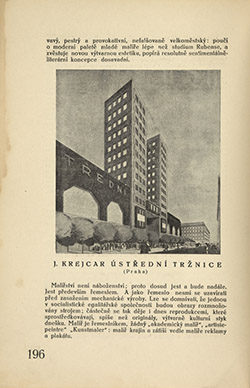
Teigeho Devětsil wanted to create a new human through art
 |
The collapse of humanitarian ideals during World War I led to ideas of a new community and, together with the Soviet revolution, to the notion of the demise of the old order. In this atmosphere, the post-war avant-garde movement grew.
The turbulent development of science led artists to the idolization of machines, mechanical beauty, and a utopian vision of unlimited technical and social progress. Artistic works began to be constructed from new materials, inspired by the use of electricity, radio, and the transformation of sound waves into light.
This development carried thoughts about the salvific function of art, which was meant not only to enrich and refine people but to transform them internally, to become the creator of an optimal living environment, shaping the habits and behaviors of its users. Art was to be created for the people, brought closer to the widest audience possible.
The bearers of these ideas concentrated in the association Devětsil, which became the ideological focal point of Czech avant-garde. The artistic union was founded on October 5, 1920, in the Union Café by a small group of young artists, but it soon grew. The initiator, main organizer, and theoretical spokesperson was Karel Teige.
This grouping, whose name was derived from a small but tenacious plant, passed through various phases of its development with around 60 artists. Among others, Vítězslav Nezval, Jiří Wolker, Konstantin Biebl, Jaroslav Seifert, František Halas, Vladislav Vančura, Jiří Voskovec, Jan Werich, Jaroslav Ježek, Adolf Hoffmeister, Jindřich Štyrský, Toyen, and František Muzika were involved.
Throughout the 1920s, it gathered most of the progressive writers, painters, architects, photographers, theater practitioners, musicians, critics, and publicists of the young generation. Its theoretical postulates formed the basis for almost an entire generation's worldview.
The artists of Devětsil sought a way out through humility and tradition, inclined towards the simplest things and the fundamental values of life. The first unofficial exhibitions were organized shortly after World War I in vacant apartments and in shop windows. The first spring exhibition of Devětsil followed in May 1922. Lecture evenings were added, and in the autumn of 1922, the first revolutionary anthology of Devětsil was published.
From proletarian art, the creators later shifted to modern-oriented work, as seen in the subsequent anthology Life II - Anthology of New Beauty. It contained articles on the aesthetics of machinery, on advertising, on the architecture of transatlantic liners, photographs from films, machine images, Native American sculptures, and others.
 |
New forms of art emerged - collages and photomontages, so-called image poems. Scissors and glue replaced brushes and pens. From 1923 to 1926, Štyrský, Toyen, Teige, and Nezval worked on these. To this day, only a few unique examples of image poems have survived, but they found significant application in period press.
Poetism, as a distinctly Czech literary movement, originated in the environment of Devětsil in 1923. It brought a new poetic poetics, characterized by a sense of fantasy, improvisation, playfulness, charm to feelings and senses. Its main bearer was mainly Nezval, whose dazzlingly illogical, fantasy-rich poems were published in the collections Devětsil and Life II.
The influence of poetism can also be found in the work of the Liberated Theatre, which was founded at the beginning of 1926 as a theatrical section of Devětsil. A year earlier, the union gained a permanent publishing base at the Odeon publishing house, but after a few years, its influence began to wane.
In 1929, the Liberated Theatre also ceased its activity as a section of Devětsil and became the stage of Voskovec and Werich. With a significant diversity of political opinions within the group and the emergence of new magazines, the Union of Modern Culture Devětsil (renamed in 1925) effectively ceased to exist at the beginning of 1931.
The English translation is powered by AI tool. Switch to Czech to view the original text source.
0 comments
add comment











